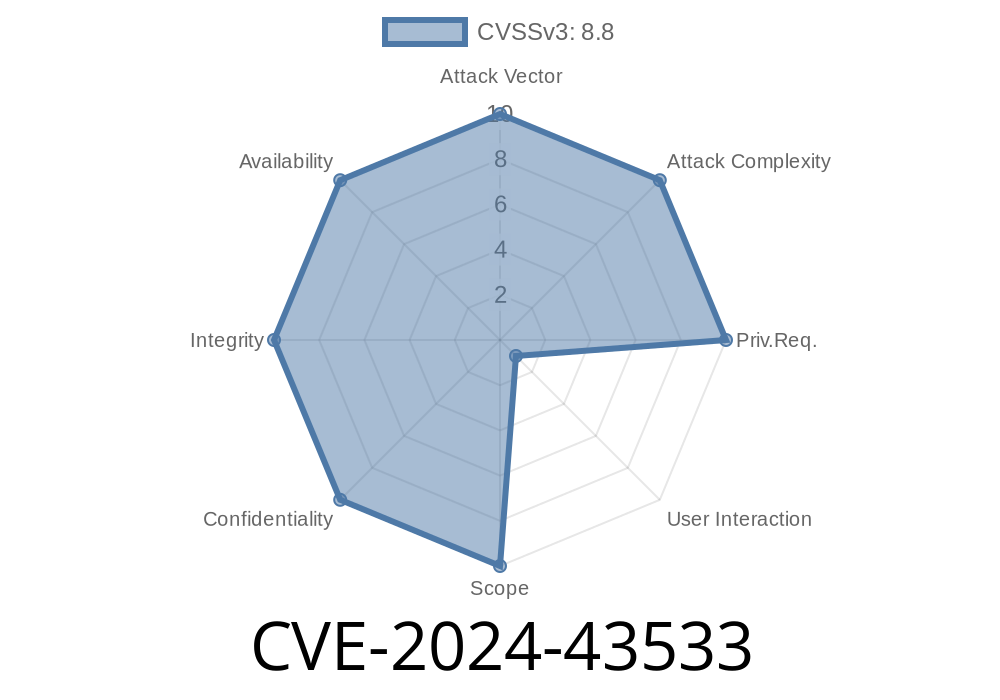The security world has been bustling with talks about CVE-2024-43533, a critical Remote Code Execution (RCE) vulnerability that affects popular Remote Desktop Client software. If exploited, this bug allows attackers to run malicious code on a victim's machine by tricking them into connecting to a rogue Remote Desktop server. Let’s break down what this vulnerability is, how it works, and what you can do to protect your systems.
What is CVE-2024-43533?
CVE-2024-43533 was publicly disclosed in June 2024 and affects the Remote Desktop Client provided by Microsoft in Windows and several open-source RDP clients. The flaw involves improper validation and handling of protocol messages during an RDP session. When an unsuspecting user connects to a malicious server, the server can send specially-crafted packets that trigger a memory corruption, leading to remote code execution with the user's privileges.
- Affected Products: Microsoft Remote Desktop Client (Windows 10, 11), FreeRDP, and potentially others.
Attack Vector: Network (No authentication required)
- Discovery: Reported by security researchers at CERT/CC.
How Does the Exploit Work?
Attackers set up a rogue RDP server. When a victim connects—thinking it's their usual remote machine—the server sends malformed graphical update packets. A bug in the client’s message parser—an unchecked buffer copy—lets the attacker overwrite memory and inject shellcode.
Simplified Exploit Flow
1. Attacker sets up a malicious RDP server using publicly available tools (such as xrdp or patched FreeRDP).
Malicious server sends crafted bitmap update message that exceeds expected size.
4. The client processes the message and, due to lack of bounds-checking, overwrites memory with attacker's payload.
Code Snippet: Rough Exploit Demo (Educational Purposes Only!)
Here’s a simplified Python snippet demonstrating how such a message might be sent by a rogue RDP server (note, this is for illustrative/educational purposes only!):
import socket
import struct
# Simplified example: Crafting a large bitmap update message
bitmap_update = b'\x00' * 1024 # Oversized payload to trigger buffer overflow
def start_malicious_rdp_server(host='...', port=3389):
s = socket.socket(socket.AF_INET, socket.SOCK_STREAM)
s.bind((host, port))
s.listen()
print(f"[+] Malicious RDP server listening on {host}:{port}")
client, addr = s.accept()
print(f"[+] Connection from {addr}")
# Negotiate phase skipped for simplicity, directly send crafted message
client.sendall(bitmap_update)
client.close()
if __name__ == "__main__":
start_malicious_rdp_server()
This snippet skips real protocol negotiation for readability. Real-world exploits would handle authentication and proper RDP message formatting.
Original References and Resources
- Official Microsoft Advisory: ADV230024 - CVE-2024-43533
- NVD Summary: NIST NVD CVE-2024-43533
- CERT/CC Note: VU#732495
- FreeRDP Security: FreeRDP GitHub Advisories
Conclusion
CVE-2024-43533 is a potent reminder of why keeping software up to date and being mindful of remote connections is crucial. Remote desktop is an indispensable tool, but as this vulnerability shows, it can also be a major target.
Stay alert for updates, and always verify who you’re connecting to—your endpoint security might just depend on it.
*This post is for educational awareness only.*
Timeline
Published on: 10/08/2024 18:15:17 UTC
Last modified on: 12/10/2024 18:45:35 UTC
